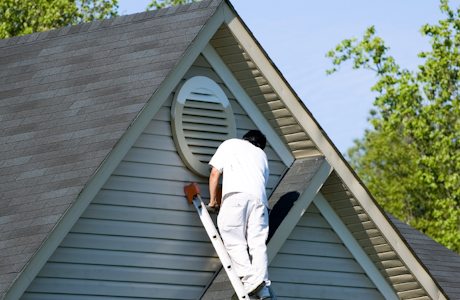Exterior Painting Safety and Equipment
Embarking on an exterior painting project involves more than just selecting the right paint color and type. Safety is equally vital, especially when working at heights and dealing with various environmental elements. In this blog post, we’ll discuss the essential safety measures and equipment required for exterior painting, and we’ll delve into the best practices for ladder and scaffold use.
Necessary Safety Measures and Equipment
- Personal Protective Equipment (PPE)
To ensure safety during an exterior painting project, you should equip yourself with the right PPE. This includes goggles to protect your eyes from paint splatters, gloves to shield your hands, appropriate footwear to prevent slips, and a respirator or mask if you’re working with potentially toxic paints or solvents.
- Sun Protection
Since exterior painting often involves prolonged exposure to the sun, protect yourself from sunburn and heat exhaustion with sunscreen, a wide-brimmed hat, and long sleeves.
- Proper Clothing and Footwear
Wear clothes that you don’t mind getting paint on, but make sure they’re not too loose to avoid getting caught in ladders or scaffolding. Shoes should have non-slip soles to provide stability and prevent falls.
- Safety Harnesses
For high exterior painting jobs, a safety harness can be a lifesaver. A harness attached to a stable fixture can prevent serious injuries from falls, especially when working on a roof or a significantly elevated surface.
Best Practices for Ladder and Scaffold Use
- Ladder Safety
– Proper Positioning: Always place the ladder on a stable, even surface. Follow the 4-to-1 rule: for every four feet of height you’re climbing, move the base one foot away from the wall.
– Maintaining Balance: Keep your body centered between the rails of the ladder. Do not overreach; move the ladder instead.
– Regular Inspections: Before each use, inspect the ladder for cracks, loose parts, or other damage.
- Scaffold Safety
– Stable Setup: Ensure that the scaffold is set up on level ground, with all its wheels or base plates fully supported.
– Avoid Overloading: Be mindful of the weight limit of the scaffold and avoid overloading it with equipment or paint containers.
– Securing the Scaffold: Use guardrails and toe boards to prevent falls and dropping tools or paint.
- Awareness of Surroundings
– Mindful of the Environment: Be aware of your surroundings, including overhead power lines, windy conditions, and uneven ground.
– Buddy System: Whenever possible, work with a partner. This ensures that someone is there to help in case of an emergency.
- Climbing and Descending Safely
– Always face the ladder or scaffold when climbing or descending.
– Use both hands for support, carrying tools in a belt or by using a rope to pull them up once you’re in position.
Conclusion
Safety is essential in an exterior painting project, especially when working at heights. It requires careful planning, the right equipment, and adherence to best practices. By equipping yourself with the necessary safety gear and following proper ladder and scaffold use guidelines, you can ensure a safe and successful painting experience. Remember that no painting job is so urgent that it outweighs the importance of your safety. Take your time, prepare adequately, and your painting project will not only be rewarding but also safe. Happy and safe painting!


0 Comments